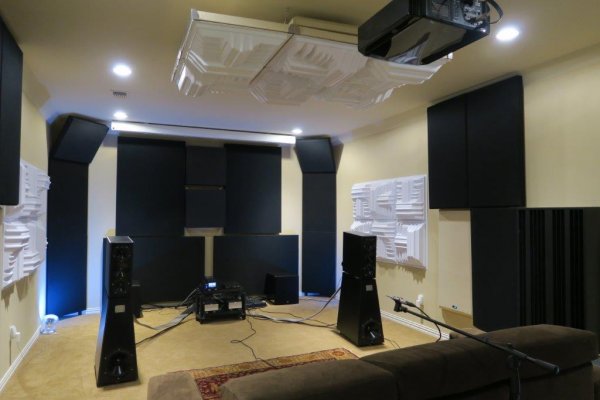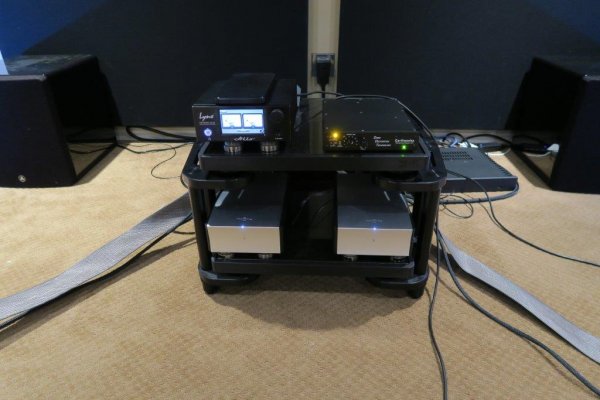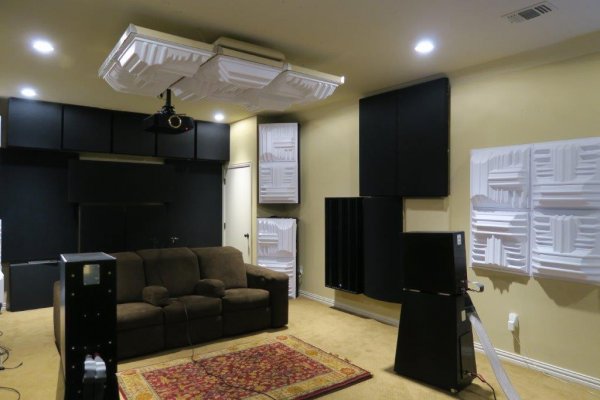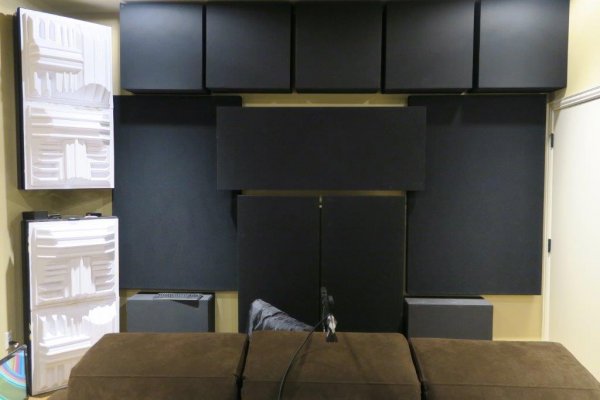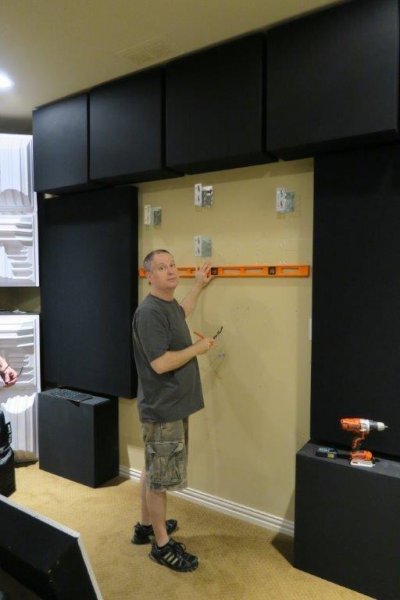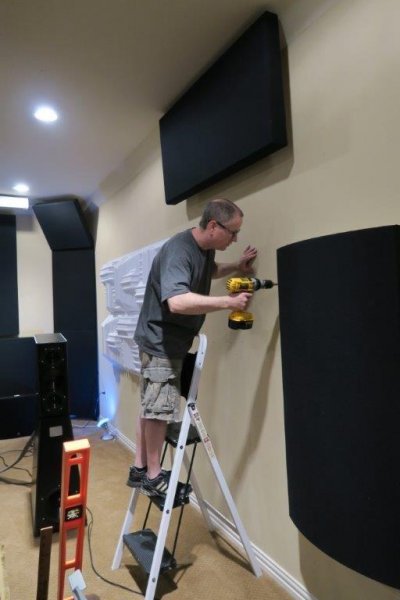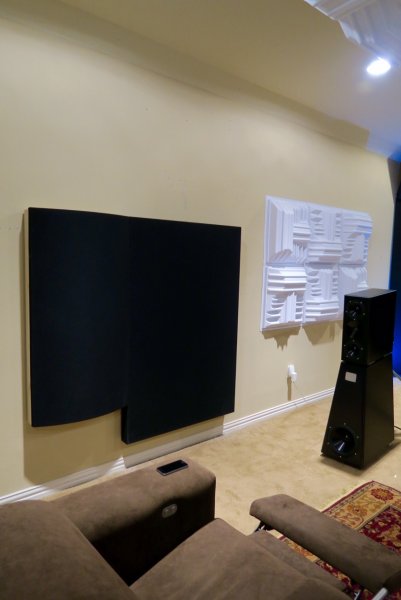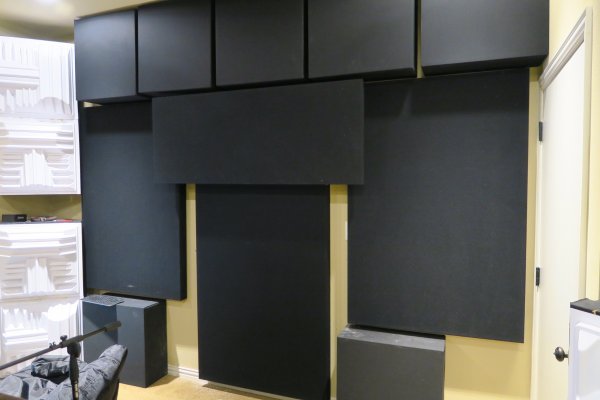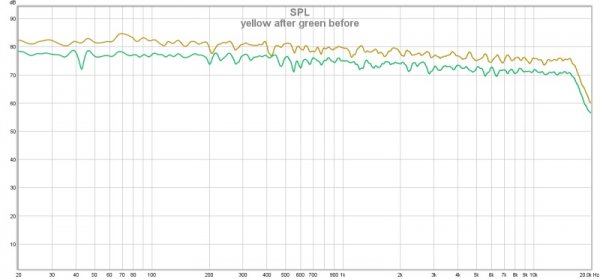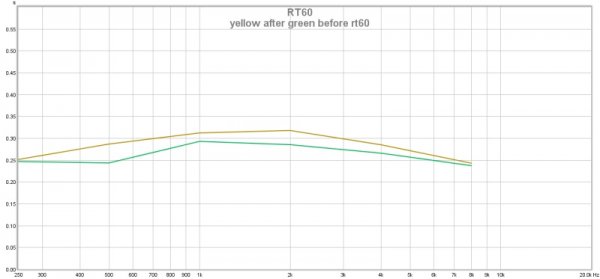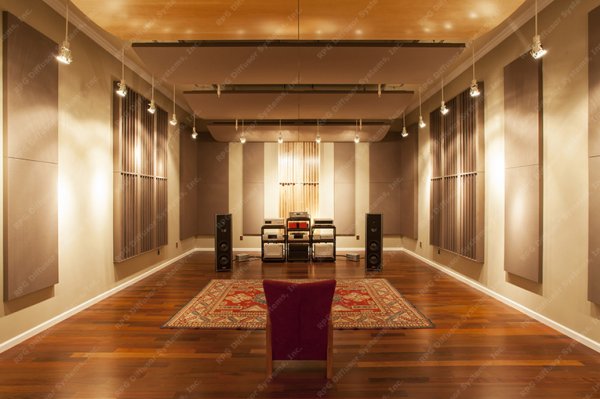Okay. I don't mean they are free of cost. As a matter of fact, they are very expensive. They are probably the most expensive bass trap on the market. However, I think they are the best value going in room acoustic treatment. This last weekend, my dealer Scotty Warren and friend Bill Gainer installed 3 additional modex plates into my room. Before these 3, I already had 6 modex plates in my room. In the post below are some pictures of the side walls and and rear walls before the new modex plates were install. I am showing these photos to demonstrate how many "conventional" panels a modex plate can replace. Later on, I will explain AND demonstrate the advantages Modex Plates offer over fiberglass panels (even great ones like RPG BAD panels). You might also ask me; Why would you want to add 3 more Modex Plates to your room? Isn't 6 enough already? Before I do that, I think it's important to discuss how fiberglass panels work and how that's different from a VPR like the Modex Plate works.
PRESSURE VS. VELOCITY
The standard in room treatments has been fiberglass panels. They can be very effective at reducing low frequency ringing from about 100hz to 300hz. Their performance can even be extended below 100hz depending on their thickness and some other mounting tricks. Fiberglass works on velocity. Fiberglass can reduce the bass wave's velocity and thereby mitigate room ringing. Of course, velocity is at its greatest away from the walls in a room. So fiberglass doesn't work so well mounted directly onto a flat wall. However, fiberglass can be mounted on "off sets" which create a 4" air gap from the wall. This can greatly increase their performance along with using very thick panels.
There's a "cost" with fiberglass though. Fiberglass will absorb a lot of midrange and high frequencies. Moreover, the closer a panel is located to the speaker, the more the panel will color the speaker at the seated position. This is especially true if one elects to use absorption on sidewall lateral 1st reflection points. I know there's much controversy here and Floyd Toole has done some research suggesting that no panels should be used in this location. However, there's no universal here. In my case, I like to use absorption at these reflection points. I believe I can get a smoother midbass and the measurements bear that out. However, it takes a lot of fiberglass panels to do the trick. And even the best fiberglass panels will absorb a little too much midrange and high frequency. RPG BAD panels are designed to mitigate this effect with a perforated wood plate which is mathematically proven to diffuse the mid and HF much more evenly. However, even BAD panels aren't great and too many of them can reduce the decay times in a room to a VERY low level. So, that's the cost for fiberglass. You have to use sooooooo many of them to get great bass that you suck out too much HF and make the room sound a little unnatural.
RPG Modex Plates work by reducing bass wave pressure. I don't know how to build one and I can't give you a technical paper on how they are designed. I know that RPG sells them on license from a German manufacturer. I don't believe there are any other companies selling VPRs. Modex Plates must be mounted directly onto a wall wherein high pressure bass energy accumulates. So, knowing where to install the modex plate requires some basic room acoustics knowledge. In my case, my room is 14'6" wide, 24' long and 9'3" high. Of course, the lowest frequency ringing is length axial with the most dominate mode being 47hz and another half wave at 23hz. There would be many others as well if the room were untreated.
At this pointed, my room is very well controlled in the low frequencies. A few years ago I started getting room acoustics help from Nyal Mellor. This relationship started me on the path to room acoustics learning. I've learned a lot since then. I regularly use a mic and REW. Let's just say that the room treatment, my seated position, speaker positions, digital crossovers, DSP and subwoofers are not haphazardly setup in my room based on hand claps or listening to the soundtrack for The Movie U571 or Saint Saens Symphony No. 3.
Yes, I said it. Modex Plates are "free." They don't absorb midrange and high frequency. The absorb low frequencies better than any other product on the market. That's actually a fact and RPG has real data testing to prove it. So, I'm not blowing smoke here. These things work very well. I am going to post some pictures below starting with what my room looked like before I install these last 3 modex plates. Then I will show some photos of the install and finally some photos of what they look like now.
I have been taking REW measurements and I am confident in saying two things.
1. The3 Modex Plates (1 type two Modex Plate and 2 type one Modex Plates) installed easily perform as well or better than all of the 8 very thick fiberglass panels and two QRD diffusers (6 of which were BAD panels). Most of these panels were at least 5" thick, some thicker.
2. The decay time in my room is greatly improved since I've removed these numerous fiberglass panels from my room and replaced them with 3 "free" Modex Plates.
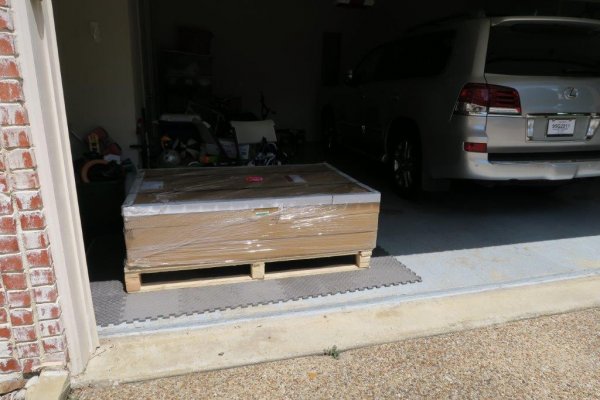
PRESSURE VS. VELOCITY
The standard in room treatments has been fiberglass panels. They can be very effective at reducing low frequency ringing from about 100hz to 300hz. Their performance can even be extended below 100hz depending on their thickness and some other mounting tricks. Fiberglass works on velocity. Fiberglass can reduce the bass wave's velocity and thereby mitigate room ringing. Of course, velocity is at its greatest away from the walls in a room. So fiberglass doesn't work so well mounted directly onto a flat wall. However, fiberglass can be mounted on "off sets" which create a 4" air gap from the wall. This can greatly increase their performance along with using very thick panels.
There's a "cost" with fiberglass though. Fiberglass will absorb a lot of midrange and high frequencies. Moreover, the closer a panel is located to the speaker, the more the panel will color the speaker at the seated position. This is especially true if one elects to use absorption on sidewall lateral 1st reflection points. I know there's much controversy here and Floyd Toole has done some research suggesting that no panels should be used in this location. However, there's no universal here. In my case, I like to use absorption at these reflection points. I believe I can get a smoother midbass and the measurements bear that out. However, it takes a lot of fiberglass panels to do the trick. And even the best fiberglass panels will absorb a little too much midrange and high frequency. RPG BAD panels are designed to mitigate this effect with a perforated wood plate which is mathematically proven to diffuse the mid and HF much more evenly. However, even BAD panels aren't great and too many of them can reduce the decay times in a room to a VERY low level. So, that's the cost for fiberglass. You have to use sooooooo many of them to get great bass that you suck out too much HF and make the room sound a little unnatural.
RPG Modex Plates work by reducing bass wave pressure. I don't know how to build one and I can't give you a technical paper on how they are designed. I know that RPG sells them on license from a German manufacturer. I don't believe there are any other companies selling VPRs. Modex Plates must be mounted directly onto a wall wherein high pressure bass energy accumulates. So, knowing where to install the modex plate requires some basic room acoustics knowledge. In my case, my room is 14'6" wide, 24' long and 9'3" high. Of course, the lowest frequency ringing is length axial with the most dominate mode being 47hz and another half wave at 23hz. There would be many others as well if the room were untreated.
At this pointed, my room is very well controlled in the low frequencies. A few years ago I started getting room acoustics help from Nyal Mellor. This relationship started me on the path to room acoustics learning. I've learned a lot since then. I regularly use a mic and REW. Let's just say that the room treatment, my seated position, speaker positions, digital crossovers, DSP and subwoofers are not haphazardly setup in my room based on hand claps or listening to the soundtrack for The Movie U571 or Saint Saens Symphony No. 3.
Yes, I said it. Modex Plates are "free." They don't absorb midrange and high frequency. The absorb low frequencies better than any other product on the market. That's actually a fact and RPG has real data testing to prove it. So, I'm not blowing smoke here. These things work very well. I am going to post some pictures below starting with what my room looked like before I install these last 3 modex plates. Then I will show some photos of the install and finally some photos of what they look like now.
I have been taking REW measurements and I am confident in saying two things.
1. The3 Modex Plates (1 type two Modex Plate and 2 type one Modex Plates) installed easily perform as well or better than all of the 8 very thick fiberglass panels and two QRD diffusers (6 of which were BAD panels). Most of these panels were at least 5" thick, some thicker.
2. The decay time in my room is greatly improved since I've removed these numerous fiberglass panels from my room and replaced them with 3 "free" Modex Plates.

Last edited:


